Category: About My Individual Curatorial Portfolio
29 Dreaming Artists Collective
Due to the constraints of the exhibition budget, this exhibition could not select some very famous art works as exhibits, so I decided to focus on the selection of exhibits on whether the works can resonate with the audience. I need these works to create a space between reality and illusion for the audience, so that the audience can step into the flow of dreams that cannot be fully interpreted when entering the exhibition. I set three criteria for selection around this goal. First, the theme of the work should be related to dreams, subconscious, memory, etc. Second, the form of the work should be immersive and interactive, which can bring sensory stimulation to the audience to enhance the sense of experience. Third, the artistic language of the work should be open, which can allow multiple interpretations from different perspectives.
In addition, I tend to choose the works of emerging artists, not only because of the constraints of exhibition budget, new artists often have more freedom of expression and more experimental creative language, and are more closely linked to the local youth cultural community, which can enhance the location of the exhibition.
The following is my exhibit list:
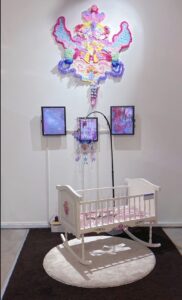
Hotbed’s Alibi, Jie Xie, 2024
Variable size
crib, acrylic, monitoring equipment, display, carpet
“For childhood memory loss, it may be trauma caused by not receiving a positive response to a strong psychological need, and these traumas do not disappear, but appear in more subtle ways, such as nightmares, automatic fantasies, memories actively creating false and true confusion, invasive images, or sudden flashes of memory fragments.” Sometimes it can occur in more dangerous ways, such as repetitive compulsion, where you recreate the traumatic experience you had as a child and repeat the same traumatic patterns. I want to reconnect and pay attention to everyone’s inner child, to confront the trauma, missing or unmet needs, beliefs and patterns of behavior that may have existed during childhood, rather than avoid and fear the trauma and memory loss.” (Jie Xie, 2024)
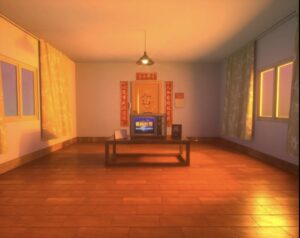
The scene of the virtual dreamscape, Haoyang Chen, 2024
Variable size
video
“Nostalgia is a uniquely human emotion that can bring us comfort and insight. I create a virtual dream filled with Chinese nostalgia, a space that is both connected to the past and full of infinite possibilities, so that young people can reconnect with the past, rekindle their expectations for life, regain their longing for the future, and face the present life with a hopeful attitude. Continue the expectations and imagination of contemporary youth for the future. In this virtual world, I want them to feel familiar and free. You can temporarily get rid of the shackles of the real world, find inner peace and freedom, and pursue the life you really want in the future.” (Haying Chen, 2024)
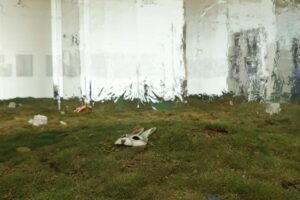
Alice, Jieyu Tan, 2021
Variable size
video equipment, ha ha lenses, dirt, turf
“Alice in Wonderland Syndrome” as a mental illness in childhood, from the beginning of the name to reveal its symptoms. The main material of this installation work is Ha-ha lens. When the viewer is in it, the distorted sense presented by the mirror reflects the pressure, distortion and alienation of the contemporary people. At the foot of the installation, there is a soft lawn, and the rabbit hole is in the center, just like “Wonderland” as a dream woven by Alice’s patient. To escape all the discomfort of real life. The sensory experience brought by the whole space atmosphere of the work is unreal, and it is a metaphor for the contradictions and struggles between illusion and reality, reality and ideal, distortion and calm, pressure and escape of contemporary people. (Tan Jieyu, 2021)
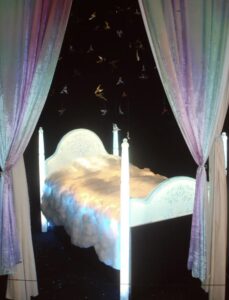
Good Night, Ziyue Jin, 2024
90cm*180cm*120cm
glass, resin, bed frame, cotton, curtains
“Due to the somatization reaction of severe depression, I can spend 24 hours a day lying in bed, which seems to have become an important organ of my body. What is more magical is that the plots in my dreams can be connected like TV dramas, and the places in my dreams can also be spelled into a complete map, as if the existence of a different world. In the dream, there are two kinds of fish, the good fish can walk freely in the sky, and the bad fish will be locked in the cage, which will make me afraid. Due to severe autism and anxiety, fewer and fewer friends kept in touch with me, and the waking time was painful for me. I began to look forward to dreaming every night. Many warm and luminous fish were my good friends.” (Ziyue Jin, 2024)
28 source of funds part 2
Support program for young curators of Guangdong Provincial Art Museum
link:https://whly.gd.gov.cn/gkmlpt/content/4/4518/post_4518599.html#2630
(*Guangzhou serves as the provincial capital of Guangdong, a bit like how Edinburgh functions within Scotland. That is why I will further search for resources available in Guangdong Province.)
I also searched for available funds in Guangdong Art Museum Association and finally found this “Guangdong Art Museum Young Curators Support Program”. This fund is jointly organized by the Guangdong Provincial Department of Culture and Tourism, the Guangdong Provincial Art Museum Association and the Guangdong Art Museum, and the province’s state-owned and private art museums can recommend curators to apply for exhibitions in the museum. Another Art Museum where I have a personal curatorial project fits that bill. Secondly, the declaration of this fund requires a complete exhibition planning plan, and the exhibition must be independently planned by the applicant. My personal curatorial project has already had a complete curatorial plan and was completed by myself independently, which meets this standard. Finally, Another Art Museum can provide the guarantee of the site and hardware facilities to ensure that my personal curatorial project can be implemented in the museum as planned, which meets the condition of applying for funds that “the applicant should fully demonstrate the rationality and feasibility of the exhibition planning scheme submitted by the applicant and promise that the exhibition can be implemented in the museum as planned”.
Based on previous years, my personal curatorial project was able to receive about £10k from this grant.
27 Source of funds part 1
After the exhibition planning is basically complete, I need to start to consider some objective conditions that will affect the exhibition, such as available funds. I plan to find available funds as much as possible, and then further refine the exhibition according to the combination of funds. With this as a starting point, I started a search for funding programs for exhibitions in China. Below are a few of the funding schemes eligible for my personal curatorial project.
Guangzhou special fund for the development of culture and tourism industry
link:http://wglj.gz.gov.cn/gkmlpt/content/9/9725/post_9725881.html#886 (This is last year’s rule announcement, this year’s funding application has not yet started, so there is no rule announcement.)
Since my exhibition is held in Guangzhou, I first thought of looking for resources on the websites of relevant government departments in Guangzhou. I think my personal curatorial project meets the requirements for the application of this fund. First of all, it is clearly mentioned in the relevant rules of this fund that the project to declare the fund must be “a cultural and artistic project with public benefit attributes and open to the public.” My personal curatorial project takes dreams and subconscious as the theme, and I plan to let the audience experience the journey of individual subconscious mind in dreams through art works, multimedia installations and other forms. Meanwhile, I will hold two artistic creation workshops in the exhibition hall during the exhibition period, which is highly consistent with the “cultural benefits for the people” emphasized in the policy. Secondly, my personal curatorial project has initially built an execution system: The venue will cooperate with Another Art Museum in Guangzhou. The Art museum team will provide part of the necessary technical equipment, and the venue will publicize the exhibition on various social media. The proposed budget plan of the exhibition strictly follows the “special funds for special purposes” in the fund application rules, and the core expenditure will be concentrated on the necessary links such as the transportation of works.
According to the funding criteria published on the website, the maximum amount of funding for a single project is no more than 1.5 million RMB (about £150k). According to the standards, my personal curatorial project belongs to the third category of municipal projects/innovative practice projects. The amount of money that similar emerging art exhibitions can get from this fund is 50,000-150,000 RMB (about £5K-15K), so I expect my exhibition to get about £5k from this fund.
21 Venue for individual exhibition projects
Based on the initial idea of a personal curatorial project and the results of field investigation, I finally decided to choose the exhibition venue between Tramway in Glasgow and Another Art Museum in Guangzhou. The two venues each have their own advantages that fit the theme of the exhibition, but also have their own limitations. Here are some of my specific comparative analysis of various aspects of the two venues.
Space characteristics and hardware facilities
The two galleries were converted from abandoned Spaces: Tramway was converted from an abandoned tram factory, while Another Art Museum was formerly a pharmaceutical factory. As part of Glasgow’s industrial heritage, the Tramway main gallery has an extremely high height and a large number of exposed metal structures, which are ideal for large-scale installations or immersive environments.
The main exhibition hall of Another Art Museum also has spacious interior space. Different from the main exhibition hall of Tramway, the exhibition hall of Another Art Museum has three floors, among which the middle of the first and second floors is set up an empty space to accommodate large-scale installations, and the rest is a classic white cube space. This unadorned interior space provides ample leeway for the curators to play freely around the theme of the exhibition.
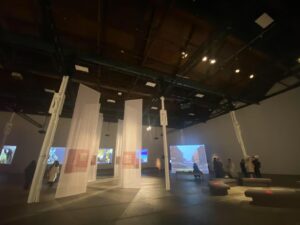
Tramway’s main exhibition hall
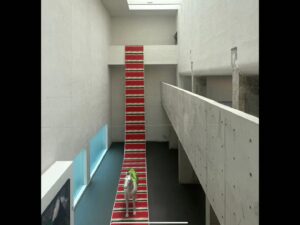
Another Art Museum’s main exhibition hall
Geographical environment, audience base, resource support and theme freedom
The inevitable part of holding an exhibition is to comprehensively consider the local urban cultural background, the audience base and a series of other objective factors. Glasgow, where Tramway is located, and Guangzhou, where Another gallery is located, each have their own strengths in hosting contemporary art exhibitions. Glasgow, where Tramway is located, has a long artistic tradition and is known for its rich art education resources (such as the Glasgow School of Art) and strong contemporary art atmosphere. The audience here is mainly art students, scholars and art industry practitioners, and the audience is highly receptive to conceptual art, experimental video and social critical works. In addition, Glasgow’s exhibition funding comes from the Public Art Fund, which is suitable for collaboration with academic institutions and the European Art Network. If my exhibition wants to explore the subconscious, psychology, social dreams in depth, Glasgow’s art ecology and academic environment will provide ideal support. Guangzhou, where Another Art Museum is located, is one of China’s economic and cultural centers. With a large audience of young people in Guangzhou who are receptive to interactive, immersive experiences and digital art, social media (e.g., Xiaohongshu, Douyin, Weibo) can quickly amplify the impact of an exhibition. If my exhibition can highlight the sense of technology, new media art and immersive experience, Guangzhou is undoubtedly the ideal choice. However, curatorial freedom in Guangzhou can be limited by Chinese cultural censorship, and some works involving social and conscious exploration may need to be adjusted. In addition, Guangzhou’s art market is highly commercialized, and exhibitions need to find a balance between artistry and market demand.
19 Further planning for personal exhibition projects
After the presentation in week6, I received many suggestions from teachers and classmates about my personal curatorial project. Therefore, I have started to think deeply about several aspects of the exhibition that are lacking at present.
The first is the exhibits. Although this project does not need to be realized, I still have to consider everything as an emerging curator during the planning, so some works by well-known artists that I envisioned at the beginning need to be excluded from consideration (such as some works by Dali and Yayoi Kusama). I need to find some emerging artists who are waiting for exhibition opportunities to fill my exhibition. Secondly, the exhibition is mainly for the group. Since the exhibition could not be directed by very well-known artists, I needed to focus on the groups who were more easily attracted by the publicity information, such as local students and art lovers. There is also the issue of venue and funding allocation. As an emerging curator, I do not have a large exhibition budget, so I should pay more attention to cost performance and fit with exhibitions when choosing venues, rather than blindly pursuing some well-known venues. I will go into more detail about all aspects of the exhibition planning in the following blog posts.
15 SOME THOUGHTS ON THE ABOVE THEORIES part 4
As art theories with far-reaching influence in modern and contemporary times, relational aesthetics theory and surrealism respectively focus on social interaction and subconscious liberation, attempting to subvert traditional art paradigms. However, these two theories still expose many limitations in the new contemporary cultural context.
In the theory of relational aesthetics, Boucheux argues that art should construct “social gap” through temporary communities, but this vision is too idealistic and ignores the hidden authority behind participatory art. Even if the audience is invited to “co-create” the work, the curators and artists still control the space rules and the allocation of resources; Some participatory art may be commercially funded, which makes the emotional sharing in its connotation a marketable commodity; Some marginalized groups are often excluded from participatory art because of technical barriers or cultural barriers (for example, people with disabilities may not be able to experience some participatory art that requires vision). The trend towards commodification also appears in surrealism. With the rise of consumerism, the subversive aesthetic presented by surrealism was labeled a “niche aesthetic,” and the melting clock in Dali’s painting was printed on handbags by luxury brands. Surrealism, on the other hand, pursued irrational beauty. But when modern academic institutions included surrealism in the classic school of art history, the rebellious spirit contained in it was domesticated by the “white box” space of the museum, and it became an empty and seemingly empty avant-garde art.
Do we still dream when our dreams are data, goods, weapons, or other things? There is no standard answer to this question. But through this exhibition, I want to lead the audience to think about this question and give their own answers. By stripping away the romanticized illusion of the “dream” created by power and capital, we can approach the true dream self.
14 SOME THOUGHTS ON THE ABOVE THEORIES part 3
Similarly, Lacan’s mirror stage theory exposes a limitation similar to Jung’s collective unconscious theory, that is, it ignores the subjectivity of non-Western cultures. Lacan emphasized the discipline of language on individuals in his theory, which regarded language as a neutral system and ignored the cultural discourse power represented by language itself. In non-Western contexts, native languages are forcibly replaced with colonial languages, such as African Frenchification and Indian Anglicization, and the universality of this symbol is actually the result of colonial violence. On the other hand, the Western patriarchal family structure presupposes in Lacan’s theory does not actually apply to the symbolic order of matriarchal societies in some regions. In addition to the continuation of colonial violence mentioned above, Lacan’s theory overemphasized the role of external symbols such as language and words, and ignored the possibility of body resistance field. For example, some chronic pain patients often use language to describe their pain experience. Lacan’s mirror stage theory reveals the underlying logic of an individual disciplined by a symbolic order, but in today’s digitally permeated life, this discipline has become more secretive. Therefore, we need to deconstruct the basic framework of his theory in the new cultural context. Only after realizing the limitations of Lacan’s theory can we open up the path to resist the symbolic hegemony.
13 SOME THOUGHTS ON THE ABOVE THEORIES part 2
Limitations also exist in Jung’s theory. Jung tried to give cross-cultural universality to the meaning of dreams, but his archetypal system was still essentially based on Eurocentric cognition. In the process of understanding the collective unconscious theory, I gradually feel that some aspects of Jung’s collective unconscious theory are actually a reproduction of cultural hegemony. It is undeniable that his theory provides a larger narrative dimension for understanding the deep structure of human psychology, but the problems of cultural hegemony, gender essentialism and scientific legitimacy hidden in the core of the theory become more and more obvious in the new cultural context of modern and contemporary multicultural integration and the development of science and technology. The first is its roots in Eurocentrism. On the pretext of “collective unconsciousness”, Jung stripped the cultural symbols of Asia, Africa, America and other non-European regions from their original cultural context and forcibly incorporated them into the European system centered on Greek mythology and Christianity. For example, the power of destruction and rebirth of the goddess Kali in Hinduism was classified by Jung as the prototype of the “Great Mother”. Dispelling the connotation of its original radical resistance to patriarchal oppression. Second, Jung often engaged in “academic picking” when constructing his theories, perfecting them by analyzing the dreams and art forms of non-European patients without realizing the subjectivity of these cultures. This is, in effect, a continuation of the intellectual looting of the colonial era, in which indigenous peoples’ experiences are transformed into European academic capital, while indigenous peoples remain excluded from the discourse. It seems to me that Jung’s theory is like a fine, old map of the world, on which Jung tried to condense the vast expanse of the human spirit into a finite island. However, this set is obviously not applicable in the modern and contemporary society with cultural integration, gender flow and technological breakthrough. What we need is not a new map, but a subversion of the old map and the right to draw. The individual unconscious should not be colonized by theory, we need to decolonize Jung’s theory and reconstruct it so that the collective unconscious becomes a spiritual Commons shared by multicultural subjects, rather than a cognitive tower standing in the European theoretical system.
12 Some thoughts on the above theories part 1
As Breton says, “Beauty must be shocking, or it will be nothing.” I think surrealism is not only an artistic movement, but also a spiritual revolution, whose core idea inspires us to keep thinking: when reason rules the world, have we become prisoners of order? Are there more real possibilities beyond the edge of human dreams and irrationality? Based on this, I have a new idea about the core topic of the exhibition.
In the initial conception, I planned to capture and reproduce dreams through the effect of the five senses presented to the audience by art works, answering the question “What is a dream?” However, it ignores that the essence of dreams is ineffable that cannot be symbolized, and the deconstruction and reconstruction of dreams is like capturing ethereal ghosts with a large net of image symbols. Hence the paradox at the heart of the original exhibition discussion: the more we try to interpret dreams, the more we misinterpret their origin. In the theoretical system of dreams and the unconscious mind, the aforementioned theories and other theories in the system together form a complex cognitive matrix. However, due to the historical background and social form, the continuous development of digital technology and the cultural context that advocates rationality, all the above-mentioned theories have limitations in various aspects.
In his theory, Freud defined human dreams as “the disguise and satisfaction of repressed desires,” a definition itself rooted in the complex social environment of Vienna at the end of the 19th century. Politically, at that time, the liberal political forces in Austria were suppressed by conservatives, and the social control over individual internalized morality and the suppression of individual desires were strengthened. Economically, the Industrial revolution not only accelerated the urbanization of Vienna, but also led to the instability of the economic situation. The ensuing changes in the family structure (men’s authority in the family was strengthened, but women were confined to the family field) affected the competition and fear of the father’s authority in Freud’s theory. Culturally, in 19th century Europe, strict sexual repression (especially for women) prevailed, and the theories of scientific rationality, such as Darwinian evolution and the physics revolution, shook the original religious worldview. In summary, I think Freud tried to study the subconscious with the “scientific” method representing rationality at that time, trying to reveal the hidden surge of irrational power under the trend of advocating rationality at that time and the spiritual tearing of people due to a series of changes at that time. However, in a society where gender fluidity is enhanced and individual desires are infinitely amplified by the prevalent consumerism, the form of “repression” has changed, people’s “libido” is transformed into user preferences by algorithms, and the platform predicts individual desires by tracking the number of clicks, externalizing the subconscious into the label and slide matching of data flow. In addition, Freud presupposes a continuous individual self in his theory, but the modern identity split (social media personality, game role, workplace personality, etc.) makes the dream no longer belong to a single individual, but a tangle of multiple identities. When a person’s dream identity is also a delivery rider, a virtual idol, and a bank teller, it is obvious that the individual psychological framework of Freudian psychoanalysis cannot be applied directly, which also reflects the paradox mentioned earlier: the more we try to interpret dreams, the more we misinterpret the origin of dreams.

